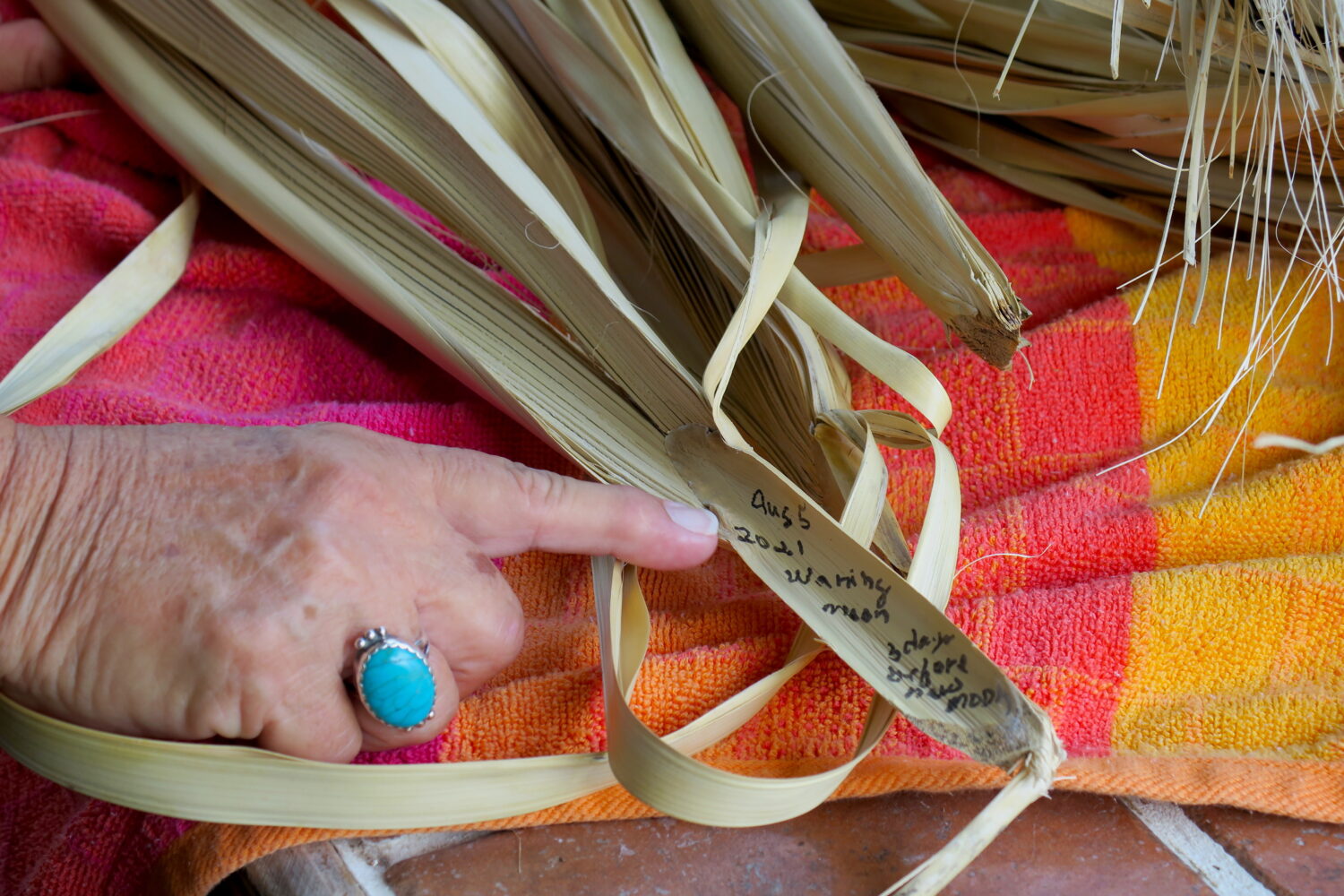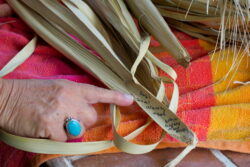Coastal
Cultural Restoration
Homes and beaches can be rebuilt after Ida, but what about culture?
Published: February 28, 2022
Last Updated: May 31, 2022

Photo by Morgan Randall
Janie Verret Luster makes a note of the date she harvested the palmetto fronds that were damaged in her home during Hurricane Ida. The phases of the moon play a role in deciding when to harvest palmetto fronds for basket weaving.
There are plenty of statistics to describe what Hurricane Ida cost Louisiana. Thirty-three lives. More than 100 square miles of wetlands erased. A projected $20 to $40 billion paid by insurers for wind losses. Agricultural damages of $584 million.
Dr. Christopher Cenac Sr. is concerned about a loss that is less quantifiable and less discussed.
“The coast of Louisiana is washing away,” he said. “But the culture is running away.”
An orthopedist based in Houma, Cenac has published three books on the history of Terrebonne Parish, including Hard Scrabble to Hallelujah, Volume 1: Bayou Terrebonne: Legacies of Terrebonne Parish, which won a 2017 Humanities Book of the Year award from the Louisiana Endowment for the Humanities. (He is now a board member for the LEH, the parent organization of 64 Parishes.) As someone who has devoted countless hours to documenting Terrebonne Parish’s transformation over the centuries, he is especially conscious of how the French-speaking population and culture in the region is shifting in response to escalating climate catastrophes.
With any storm, there are always people who decide to relocate rather than rebuild. But Ida was only one of eight named storms to batter southern Louisiana between 2020 and 2021, along with Cristobal, Laura, Marco, Delta, Zeta, Claudette, and Nicholas. Though the media plays images of the physical devastation on a loop, Cenac asserts that this doesn’t capture the crisis of cultural loss that’s unfolding.
“What you don’t see with the house blown away and the boat turned over is that the fellow who owned the house and boat fished oysters for a living,” said Cenac. Those who are unable to rebuild their home and reopen their business might seek a fresh start elsewhere. Locally, this may lead to an eroded sense of community. On a state level, tourism could decrease if cultural groups move away and their unique practices die out. Nationally and internationally, there could be limited or no access to Louisiana exports, such as Louisiana-caught shrimp, crab, oysters, and other seafood.
After Ida struck, and the weather cleared, Cenac took stock of the parish’s historical landmarks. Southwest of Houma on Bayou Dularge, he found a barn on High Ridge Plantation—unique for its English- and Scottish-influenced construction and for its beams made of whole timbers and saplings—was blown over like kindling. Just down the road, an early 20th-century building at St. Michel Plantation—which, up until Ida, had been a family’s home—was missing its roof and siding. Further south in Theriot, the building for Voisin Packing Company had collapsed on the bayou’s east bank; when we visited in October, the rubble had been cleared except for a single seafood processing machine left to reflect the sun. Cenac documented these and other sites, creating a collection of before and after photos so that places of local significance can at least endure in the historical record.
Ida was only one of eight named storms to batter southern Louisiana between 2020 and 2021, along with Cristobal, Laura, Marco, Delta, Zeta, Claudette, and Nicholas.
A few miles south of Voisin Packing Company, on the west bank of Bayou Dularge, is what remains of Janie Verret Luster’s home. Luster is a cultural preservationist and member of the United Houma Nation who was featured in the summer 2021 issue of 64 Parishes for her craftwork with garfish scales. Like Cenac, she’s contending with the issue of cultural emigration, as frequent and more extreme weather events are driving many Houma people off.
“You can’t tell someone, ‘You can’t move,’” she said. “That’s a personal decision.” Rather than try to convince people not to relocate, she’s focusing on teaching tribal members their traditions before they move away. A renowned palmetto basket weaver who has been inducted into the Louisiana Hall of Master Folk Artists, Luster was in the middle of processing palmetto fronds for a workshop when Ida struck.
The storm tore the roof from her house, causing significant water damage to her belongings. “The palmetto fronds were the first thing I saved,” she said. The process of reclaiming the fronds was tedious, involving multiple bleach baths, but she stuck with it because she knew it might be years before she could harvest palmetto again. Ida had damaged too many of the plants.
Fortunately, Luster’s hard work paid off. Though there is some discoloration from mildew on the fronds, they’re close enough to the intended pale yellow coloring and will be woven into baskets, either by Luster or those learning from her.
“I’m going to try to keep the culture going as much as I can,” she said. “Those that want to leave, I want to make sure they know about who they are, about their rich history.”
The United Houma Nation and French-speaking people of Terrebonne Parish are only two of many communities affected by Hurricane Ida. To learn more about the places and traditions impacted by the storm and how people are responding, visit 64parishes.org.
For a deeper dive into these topics, check out our online special, How to Tarp the Past.
Morgan Randall is a writer exploring stories about the relationship between cultures and our shifting environment.
 This article was made possible by the BHP-funded project, Coastal Impacts: An Integrated Approach for Community Adaptation, Understanding, and Planning, which will assist local communities to build intergenerational coastal literacy through community conversations around books, film, and exhibitions, fostering greater understanding of and support for coastal restoration projects.
This article was made possible by the BHP-funded project, Coastal Impacts: An Integrated Approach for Community Adaptation, Understanding, and Planning, which will assist local communities to build intergenerational coastal literacy through community conversations around books, film, and exhibitions, fostering greater understanding of and support for coastal restoration projects.
